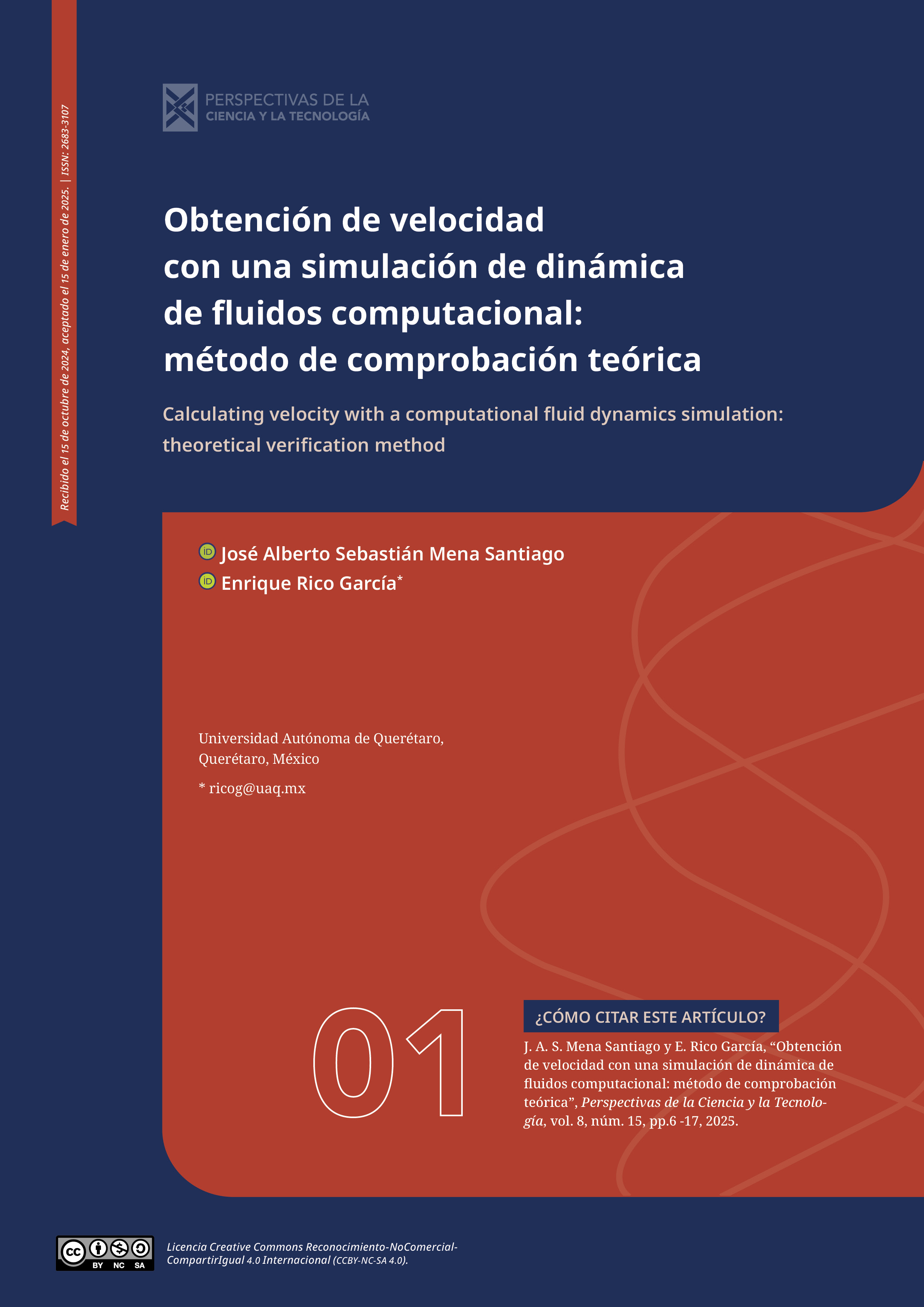Abstract
Computational fluid dynamics (CFD) is a tool used to solve problems about the behaviour of a fluid within a particular geometry in different fields by considering properties such as pressure, density, and velocity. For example, it is often used in the development of engines, turbines, hydraulic distribution systems, among others. This study analysed a water pipe with a reduction in diameter and different pressures along the system. The purpose of this paper is to estimate the effectiveness of this tool using a system of equations based on the principle of continuity and the principle of Bernoulli to calculate the entry and exit velocities by taking into account the changes in diameter of the pipe. Additionally, a simulation of computational fluid dynamics was generated in the Fluent software using a laminar flow model to compute a solution in order to compare the speeds obtained by this CFD simulation and the system of equations mentioned above. A scatter graph was made with the values obtained by the system of equations and the simulation, with an R2 of 0.9 and an average precision of 95.12% in entry speed and 95.11% in exit speed.
References
M. Kisiel y D. Szpica, “Evaluating influence of CFD mesh on flow characteristics of pneumatic brake valve differential section”, 23rd International Scientific Conference Engineering for Rural Development, 2024, doi: 10.22616/ERDev.2024.23.TF040
H. K. Versteeg y W. Malalasekera, An introduction to computational fluid dynamics: the finite volume method, 2 ed, Inglaterra; Nueva York: Pearson Education Ltd., 2007.
M. Hafiz et al., “A review: Fundamentals of computational fluid dynamics (CFD)”, en GREEN DESIGN AND MANUFACTURE: ADVANCED AND EMERGING APPLICATIONS: Proceedings of the 4th International Conference on Green Design and Manufacture 2018, Ho Chi Minh, Vietnam, 2018, art. 020252, doi:10.1063/1.5066893
T. Roy y V. Matsagar, “Mechanics of damage in reinforced concrete member under post-blast fire scenario”, Structures, vol. 31, pp. 740-760, 2021, doi: 10.1016/j.istruc.2021.02.005
T. Li et al., “Large presence of bromine and toxic metals in ambient fine particles from urban fires”, Atmospheric Environment, vol. 295, art. 119554, 2023, doi: 10.1016/j.atmosenv. 2022.119554
B. Sun, K. Guo y V. K. Pareek, “Computational fluid dynamics simulation of LNG pool fire radiation for hazard analysis”, Journal of Loss Prevention in the Process Industries, vol. 29, pp. 92-102, 2014, doi: 10.1016/j.jlp.2014.02.003
A. Pucciarelli et al., “Coupled system thermal Hydraulics/CFD models: General guidelines and applications to heavy liquid metals”, Annals of Nuclear Energy, vol. 153, art. 107990, 2021, doi: 10.1016/j.anucene.2020.107990
M. Seop Song, I. Woong Park, E. Soo Kim y Y. Lee, “Numerical study on thermal-hydraulics of external reactor vessel cooling in high-power reactor using MARS-KS1.5 code: CFD-aided estimation of natural circulation flow rate”, Nuclear Engineering and Technology, vol. 54, núm. 1, pp. 72-83, 2022, doi: 10.1016/j.net.2021.07.037
R. K. Singh y V. M. Joshi, “Validation of CFD and Thermal Hydraulics Codes by Digital Particle Image Velocimetry”, Energy Procedia, vol. 7, pp. 650-652, 2011, doi: 10.1016/j.egypro.2011.06.087
L. Wei y J. Honra, “Computational Fluid Dynamics Study on Bottom-Hole Multiphase Flow Fields Formed by Polycrystalline Diamond Compact Drill Bits in Foam Drilling”, Fluids, vol. 9, núm 9, 2024, doi: 10.3390/ fluids9090211
E. Quiroz Pérez y J. A. de Lira Flores, “Una revisión sobre el papel de la Dinámica Computacional de Fluidos en el análisis de la dispersión de gases tóxicos en plantas químicas”, Perspectivas de la Ciencia y la Tecnología, vol. 7, núm. 13, 2024, doi: 10.61820/pct.v7i13.1351
V. Sergeev, N. Vatin, E. Kotov, D. Nemova y S. Khorobrov, “Slug Regime Transitions in a Two-Phase Flow in Horizontal Round Pipe. CFD Simulations”, Applied Sciences, vol. 10, núm. 23, 2020, doi: 10.3390/app10238739
R. Aridi, S. Ali, T. Lemenand, J. Faraj y M. Khaled, “CFD analysis on the spatial effect of vortex generators in concentric tube heat exchangers - A comparative study”, International Journal of Thermofluids, vol. 16, art. 100247, 2022, doi: 10.1016/j.ijft.2022.100247
L. S. Taura, I.B.Ishiyaku y A.H. Kawo “The use of a continuity equation of fluid mechanics to reduce the abnormality of the cardiovascular system: A control mechanics of the human heart”, Journal of Biophysics and Structural Biology, vol. 4, núm. 1, pp. 1-12, 2012, doi: 10.5897/JBSB11.010
M. E. Saleta, D. Tobia y S. Gil, “Experimental study of Bernoulli’s equation with losses”, American Journal of Physics, vol. 73, núm. 7, pp. 598-602, 2005, doi: 10.1119/1.1858486
P. Wyszyński y R. Porowski, “Analysis of combustion models of hydrogen-air mixtures using ANSYS FLUENT”, Journal of Physics: Conference Series, vol. 2812, núm. 1, art. 012016, 2024, doi: 10.1088/1742-6596/2812/1/012016
P. Kusriantoko, P. F. Daun y K. E. Einarsrud, “A Comparative Study of Different CFD Codes for Fluidized Beds”, Dynamics, vol. 4, núm. 2, pp. 475-498, 2024, doi: 10.3390/dynamics4020025

This work is licensed under a Creative Commons Attribution-NonCommercial-ShareAlike 4.0 International License.
Copyright (c) 2025 Perspectivas de la Ciencia y la Tecnología


